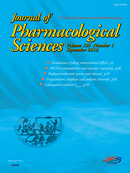Volume 123, Issue 2
Displaying 1-16 of 16 articles from this issue
- |<
- <
- 1
- >
- >|
Current Perspective
-
2013Volume 123Issue 2 Pages 79-84
Published: October 20, 2013
Released on J-STAGE: October 19, 2013
Advance online publication: September 25, 2013Download PDF (699K)
Critical Review
-
2013Volume 123Issue 2 Pages 85-101
Published: October 20, 2013
Released on J-STAGE: October 19, 2013
Advance online publication: September 27, 2013Download PDF (1779K)
Full Paper
-
2013Volume 123Issue 2 Pages 102-109
Published: October 20, 2013
Released on J-STAGE: October 19, 2013
Advance online publication: September 18, 2013Download PDF (991K) -
2013Volume 123Issue 2 Pages 110-119
Published: October 20, 2013
Released on J-STAGE: October 19, 2013
Advance online publication: October 04, 2013Download PDF (1195K) -
2013Volume 123Issue 2 Pages 120-131
Published: October 20, 2013
Released on J-STAGE: October 19, 2013
Advance online publication: September 27, 2013Download PDF (1571K) -
2013Volume 123Issue 2 Pages 132-139
Published: October 20, 2013
Released on J-STAGE: October 19, 2013
Advance online publication: September 27, 2013Download PDF (907K) -
2013Volume 123Issue 2 Pages 140-146
Published: October 20, 2013
Released on J-STAGE: October 19, 2013
Advance online publication: October 04, 2013Download PDF (1079K) -
2013Volume 123Issue 2 Pages 147-158
Published: October 20, 2013
Released on J-STAGE: October 19, 2013
Advance online publication: October 04, 2013Download PDF (1360K) -
2013Volume 123Issue 2 Pages 159-166
Published: October 20, 2013
Released on J-STAGE: October 19, 2013
Download PDF (2072K) -
2013Volume 123Issue 2 Pages 167-175
Published: October 20, 2013
Released on J-STAGE: October 19, 2013
Advance online publication: October 05, 2013Download PDF (1345K) -
2013Volume 123Issue 2 Pages 176-184
Published: October 20, 2013
Released on J-STAGE: October 19, 2013
Advance online publication: October 04, 2013Download PDF (1571K) -
2013Volume 123Issue 2 Pages 185-194
Published: October 20, 2013
Released on J-STAGE: October 19, 2013
Advance online publication: October 04, 2013Download PDF (1567K)
Short Communication
-
2013Volume 123Issue 2 Pages 195-198
Published: October 20, 2013
Released on J-STAGE: October 19, 2013
Advance online publication: October 04, 2013Download PDF (1189K) -
2013Volume 123Issue 2 Pages 199-202
Published: October 20, 2013
Released on J-STAGE: October 19, 2013
Advance online publication: October 04, 2013Download PDF (626K) -
2013Volume 123Issue 2 Pages 203-206
Published: October 20, 2013
Released on J-STAGE: October 19, 2013
Advance online publication: October 04, 2013Download PDF (900K)
Retraction
-
2013Volume 123Issue 2 Pages 207
Published: 2013
Released on J-STAGE: October 19, 2013
Download PDF (518K)
- |<
- <
- 1
- >
- >|
